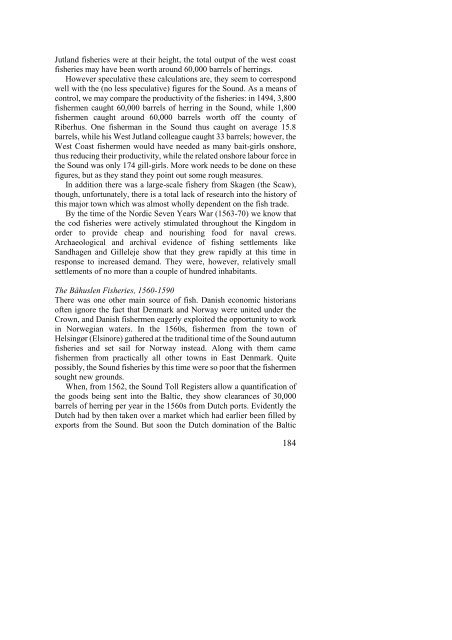The North Atlantic Fisheries, 1100-1976 - University of Hull
The North Atlantic Fisheries, 1100-1976 - University of Hull
The North Atlantic Fisheries, 1100-1976 - University of Hull
You also want an ePaper? Increase the reach of your titles
YUMPU automatically turns print PDFs into web optimized ePapers that Google loves.
Jutland fisheries were at their height, the total output <strong>of</strong> the west coast<br />
fisheries may have been worth around 60,000 barrels <strong>of</strong> herrings.<br />
However speculative these calculations are, they seem to correspond<br />
well with the (no less speculative) figures for the Sound. As a means <strong>of</strong><br />
control, we may compare the productivity <strong>of</strong> the fisheries: in 1494, 3,800<br />
fishermen caught 60,000 barrels <strong>of</strong> herring in the Sound, while 1,800<br />
fishermen caught around 60,000 barrels worth <strong>of</strong>f the county <strong>of</strong><br />
Riberhus. One fisherman in the Sound thus caught on average 15.8<br />
barrels, while his West Jutland colleague caught 33 barrels; however, the<br />
West Coast fishermen would have needed as many bait-girls onshore,<br />
thus reducing their productivity, while the related onshore labour force in<br />
the Sound was only 174 gill-girls. More work needs to be done on these<br />
figures, but as they stand they point out some rough measures.<br />
In addition there was a large-scale fishery from Skagen (the Scaw),<br />
though, unfortunately, there is a total lack <strong>of</strong> research into the history <strong>of</strong><br />
this major town which was almost wholly dependent on the fish trade.<br />
By the time <strong>of</strong> the Nordic Seven Years War (1563-70) we know that<br />
the cod fisheries were actively stimulated throughout the Kingdom in<br />
order to provide cheap and nourishing food for naval crews.<br />
Archaeological and archival evidence <strong>of</strong> fishing settlements like<br />
Sandhagen and Gilleleje show that they grew rapidly at this time in<br />
response to increased demand. <strong>The</strong>y were, however, relatively small<br />
settlements <strong>of</strong> no more than a couple <strong>of</strong> hundred inhabitants.<br />
<strong>The</strong> Båhuslen <strong>Fisheries</strong>, 1560-1590<br />
<strong>The</strong>re was one other main source <strong>of</strong> fish. Danish economic historians<br />
<strong>of</strong>ten ignore the fact that Denmark and Norway were united under the<br />
Crown, and Danish fishermen eagerly exploited the opportunity to work<br />
in Norwegian waters. In the 1560s, fishermen from the town <strong>of</strong><br />
Helsingør (Elsinore) gathered at the traditional time <strong>of</strong> the Sound autumn<br />
fisheries and set sail for Norway instead. Along with them came<br />
fishermen from practically all other towns in East Denmark. Quite<br />
possibly, the Sound fisheries by this time were so poor that the fishermen<br />
sought new grounds.<br />
When, from 1562, the Sound Toll Registers allow a quantification <strong>of</strong><br />
the goods being sent into the Baltic, they show clearances <strong>of</strong> 30,000<br />
barrels <strong>of</strong> herring per year in the 1560s from Dutch ports. Evidently the<br />
Dutch had by then taken over a market which had earlier been filled by<br />
exports from the Sound. But soon the Dutch domination <strong>of</strong> the Baltic<br />
184















